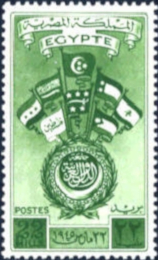

The Alexandria Protocol was an agreement signed on 7 October 1944, in Alexandria, by five Arab countries agreeing to the formation of a joint Arab Organization, which led to the formation of the League of Arab States in the following year.[1]
The agreement stated that all participating countries will be represented on an equal footing. The main aim of this organization was to strengthen the relations between Arab states and to participate actively in the coordination of their political plans and foreign policy without interference with their independence but promising protection by suitable means in case of aggression against a member state and its sovereignty.
The meeting in Alexandria included five committees with representatives of the future members of the Arab League countries in the Middle East.
- ^ Toffolo, Cris E. (2008). The Arab League. Infobase Publishing. ISBN 978-1-4381-0296-2.